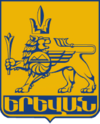Erevan
|
Yerevan Երևան |
|||
|---|---|---|---|
| City | |||

From top left: Yerevan skyline with Mount Ararat • Karen Demirchyan Complex •
Tsitsernakaberd Genocide Memorial • Saint Gregory Cathedral • Tamanyan Street and the Yerevan Opera • Cafesjian Museum at the Cascade • Republic Square at night |
|||
|
|||
| Nickname(s): "The Pink City" (վարդագույն քաղաքvardaguyn k'aghak' , literally "rosy city") | |||
 Location within Armenia |
|||
| Coordinates: 40°11′N 44°31′E / 40.183°N 44.517°ECoordinates: 40°11′N 44°31′E / 40.183°N 44.517°E | |||
| Country |
|
||
| Founded as Erebuni by Argishti I | 782 B.C. | ||
| City status by Alexander II of Russia | 1 October 1879 | ||
| Government | |||
| • Type | Mayor–Council | ||
| • Body | City Council | ||
| • Mayor | Taron Margaryan (Republican) | ||
| Area | |||
| • Total | 223 km2 (86 sq mi) | ||
| Elevation | 990 m (3,250 ft) | ||
| Highest elevation | 1,390 m (4,560 ft) | ||
| Lowest elevation | 865 m (2,838 ft) | ||
| Population (2011) | |||
| • Total | 1,060,138 | ||
| • Density | 4,800/km2 (12,000/sq mi) | ||
| Demonym(s) | Yerevantsi(s) | ||
| Time zone | AMT (UTC+4) | ||
| Area code(s) | +374 10 | ||
| Website | www |
||
Yerevan (/ˌjɛrəˈvɑːn/; Armenian: Երևան, classical spelling: Երեւան [jɛɾɛˈvɑn], ![]() listen ) is the capital and largest city of Armenia as well as one of the world's oldest continuously inhabited cities. Situated along the Hrazdan River, Yerevan is the administrative, cultural, and industrial center of the country. It has been the capital since 1918, the thirteenth in the history of Armenia, and the seventh located in or around the Ararat plain.
listen ) is the capital and largest city of Armenia as well as one of the world's oldest continuously inhabited cities. Situated along the Hrazdan River, Yerevan is the administrative, cultural, and industrial center of the country. It has been the capital since 1918, the thirteenth in the history of Armenia, and the seventh located in or around the Ararat plain.
The history of Yerevan dates back to the 8th century BC, with the founding of the fortress of Erebuni in 782 BC by king Argishti I at the western extreme of the Ararat plain. Erebuni was "designed as a great administrative and religious centre, a fully royal capital." By the late ancient Armenian Kingdom, new capital cities were established and Yerevan declined in importance. Under Iranian and Russian rule, it was the center of the Erivan Khanate from 1736 to 1828 and the Erivan Governorate from 1850 to 1917, respectively. After World War I, Yerevan became the capital of the First Republic of Armenia as thousands of survivors of the Armenian Genocide in the Ottoman Empire arrived in the area. The city expanded rapidly during the 20th century as Armenia became part of the Soviet Union. In a few decades, Yerevan was transformed from a provincial town within the Russian Empire, to Armenia's principal cultural, artistic, and industrial center, as well as becoming the seat of national government.
...
Wikipedia


